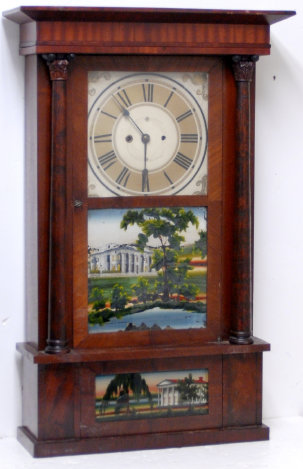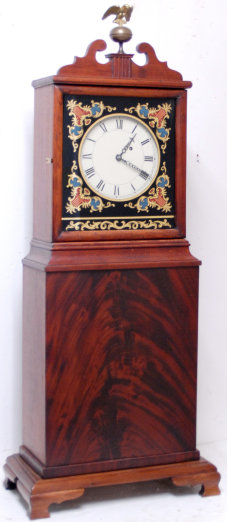426. $400
Large Cupid Mystery Swinger. Head and shoulders above any swinger
we have ever sold, and tops anything we have ever seen for the money. The brass cherub statue stands on a solid black marble base,
and is 26” high. The detail of the casting is superb, one of the best castings I have seen. The cherub has an 11” wingspan and the
marble base is 10” in diameter. With the clock arm in place on the statue the total height is 38” high. The arm alone is 33” high.
The balls are painted blue, numerals, hands, and other attached ornaments are all brass. I unpacked the clock, hung the swing arm
on the statue, and it will hardly stop running. It ran 14 days the first time I wound it. You would expect a swinger, made of solid
brass, to sell for several times our minimum. It is the best buy of all reproduction clocks we have sold. $500-$750.
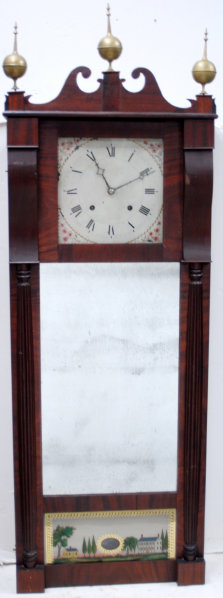
427. $1000
Joseph Ives mirror wall clock, ca 1819-1823. During this period of making wood movements for tall clocks he also invented and made long mirror cases that required long pendulums. There are examples of wood movements in the long mirror cases as well as brass movements. The case is constructed of mahogany with scrolled top, a painted tablet, and a mirror. The case is painted inside and the mirror is backed with long pieces of wood that are also painted. The case is 55 ˝ inches tall and 19 ˝ inches wide. Being 200 years old you should excuse the fact that both scrolls have been broken and repaired for most all clock scrolls have been broken and repaired. The 8-day movement, invented by Ives, has an iron back plate, pieced brass front plate, brass gears with roller pinions, a long pendulum, and is in excellent running condition. It also has an exceptional painted iron dial with decorations, 3 brass finials and 2 iron weights. We cannot say emphatically that the weights, pendulum bob, and those type accessories are original to the clock. For reference see “American Shelf and Wall Clocks” by Robert W. D. Ball, page 227; and Horology Americana” by L. Dworetsky and Robert Dickstein, page 95; and “The Connecticut Clock Technology 1810-1862”, page 46 thru 59, by Kenneth Roberts. An identical clock was sold at Cottone Auctions, October 2014. $1000-$2000.


428. $300
“C. & L. C. Ives, / Bristol, Conn.” copied from the near complete paper label. Mahogany veneered case is 38” high, with a very nice carved splat, complete chimneys and returns, full turned and carved columns in the center, and four ball feet on the bottom. It never had top or bottom half columns as many triple decker clocks had in that time period. Top door has original ivory escutcheon with door lock and key. Bottom door also has the ivory escutcheon and lock. Overall the veneer is pretty good, a chip or two and frayed edges around the doors and base. The top glass is held in place with replaced putty, but the two lower glasses are probably original. The old wood dial is good, but the mirror is missing. It has an 8-day strap brass movement with side arm extension which was one of Ives earlier brass movements. The movement has been serviced and in running order. It strikes hours on a large iron bell. There is a correct pair of old iron weights and an old pendulum bob. This is a very nice restored early triple decker clock. Similar clocks can be seen on page 58 and 67 in the book by R. W. D. Ball., “American Shelf and Wall Clocks”. $350-$550.
429. $500
Massachusetts Shelf clock, a reproduction of those popular clocks made in the 1800’s. Styles varied slightly among the several companies’ making those clocks. This one is more in the style of Silas Parson of New Hampshire, making them in 1815. The base or at least part of it appears to be very old and could have been part of an original shelf clock. As you know originals have sold as high as $50,000 which encouraged modern clock makers to reproduce them and try to reap some of the profits. The burl walnut case is 41 inches tall and 17 inches wide at the base. It has had repairs, especially on the backboard and there is a chip on one of the feet, not visible from the front. It has a nice brass eagle on top, scrolls that were popular in the 1800’s, and an excellent dial with a 5 ˝ inch time track. The reverse painting was copied from an original. Inside is a Kilbourn and Proctor 8-day, weight driven, time only movement that is in fine running condition. $500-$1000.
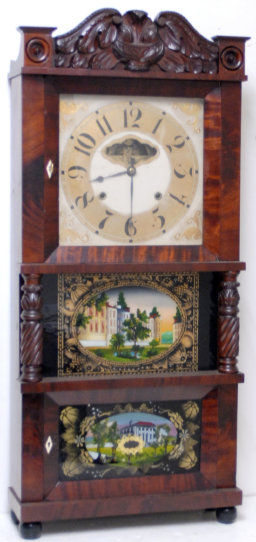
430. $250
“Birge & Fuller / Bristol, Conn.”, ca 1844. One of the early clocks made using a brass movement, much less a strap brass movement. The movement was invented and patented by Joseph Ives, and subsequently licensed to other clockmakers in the Bristol area. As you may have noticed there are some clocks in this auction with an arm extended on the left side of the movement. They were Ives first brass movements. Mahogany veneered case is 35 inches tall, good veneer all over, but you will find a few small chips on the back edges, and some light hauling scratches on the edges. The fruit basket splat has good gilt, columns have gilt except the part of the columns that are grained. Two door latches, Birge style replacement glass in the bottom door, and new mirror. The two iron weights are correct for that period and of course we cannot be sure about the pendulum bob or hands as to originality. The painted wood dial has some stretch marks and has darkened over time. It has the large center opening which “experts” claim was done so we curious folks could watch the gears move. The 8-day brass movement is clean, complete, and operational, but we do not hang heavy weights on clocks this old, especially if I do not own it. Why should I take a chance with a clock 175 years old? The movement is signed, “Birge & Fuller / Bristol, Conn. U.S.A.”. $350-$500.

431. $100
Gustav Becker box clock, they called it a Vienna, ca 1890. Case
retains the early look and some art deco design. Large glass in the door, unknown if original for it could have been removed during
case cleaning. Two-piece porcelain dial with black numerals, and correct hands, weight and pendulum bob. Walnut case is 32 inches
tall, and basically a plain case but in excellent condition. 8-day weight driven time only movement is running and the movement is
signed by Becker who as you know was one of Germany’s great clock makers. The movement has been serviced and is in great running condition.
$150-$300.
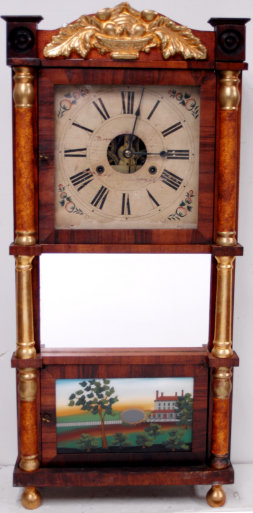
432. $500
“C. & L. C. Ives, Bristol, Conn.”, triple decker clock, ca 1832. This rare old clock is almost 185 years old and has somehow managed to stay in a nice collectable condition. The mahogany veneered case is 37, inches tall, has a very unusual splat, a complete label, and original glasses. It is almost unheard of to find all that in a clock that old. Now true the glasses had some chips and were touched up by Tom Moberg, but who wouldn’t do that? It has an excellent wood dial with gold corners and gold chapter ring with black Arabic numbers. The stenciled gold leaf splat is signed, “Brass Clocks Made by C. & L. C. Ives”. The center columns are stenciled and there are no top or bottom half columns and it never had any. The two doors have ivory escutcheons and locks, but no key. There is one of this case-style in the Connecticut State Library. Also one shown in the book, “Two Hundred Years of American Clocks and Watches”, by Chris Bailey. The same clock is on page 99, Fig.23A of KI. D. Rogers book, “The Contribution of Joseph Ives to Connecticut Clock Technology”. Our clock has four black bun feet and a large 4 ˝ inch round bell. This 8-day brass (cheese hole) movement was one of the first brass movements designed by Ives and has the side arm extension which he abandoned in a few years. This is a very nice early collectable triple decker in excellent restored condition. $500-$750.
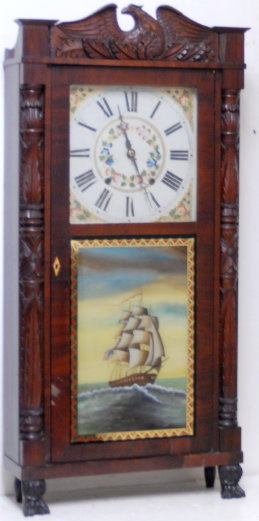
433. $300
Elisha Hotchkiss, Jr., Burlington, Conn., carved column and splat case, 30-hour wood movement, ca 1831. No label on the backboard but the movement is identified in the Spring 1993 NAWCC Bulletin Supplement No. 19, page 53, figure 131. The case, movement, and maker, are identified in that article by Bryan Rogers and Snowden Taylor. The mahogany case with carved eagle top is 38 inches tall, 18 inches wide, with carved front feet. One foot has had a chip glued in place. There is a nice professional replacement glass of a ship with gold leaf border around the glass. The iron weights may be replacements. The movement has been serviced and is in excellent running order. $300-$500.
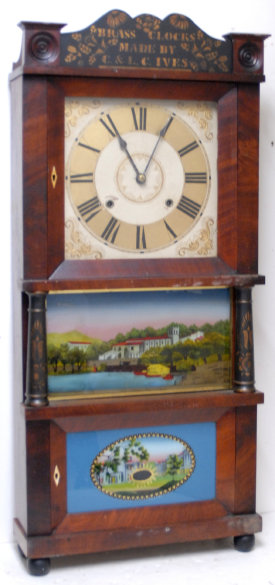
434. $800
“Spencer & Wooster & Co. / Salem Bridge, Conn.”, ca 1840. Mahogany veneered Empire style column and cornice case is 33 ˝ inches high, in very nice original condition with very few veneer edge or corner nicks. It has full turned columns, nice acanthus scrolls at tops of the capitals, and a metal turning door latch. The original painted wood dial is excellent and identical to dials shown with this model case in the reference books. The hands are correct, there is a complete paper label inside, an old pendulum bob, brass pulleys, a pair of old iron weights, and coil gong. The top glass was replaced, the middle tablet is original with some slight paint loss, and the bottom glass is a replacement painted by Tom Moberg. The company sold this model clock with the bottom glass/door three different ways; hinged, loose, or permanently fixed. This door is loose. The Salem Bridge movement is 8-day time, and gong strike, a good movement that is in good running condition. Reference: NAWCC Bulletin Supplement #13, “Heman Clark and the Salem Bridge Shelf Clocks”. Salem Bridge clocks have always been sought after by American collectors. $1000-$1500.
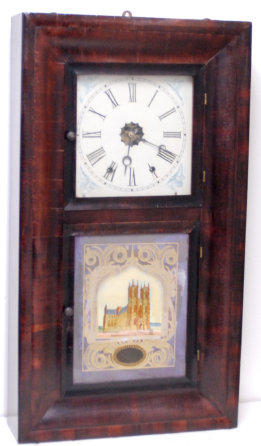
435. $150
“Chauncey Jerome, New Haven, Conn.”, eight-day brass movement in a two-door ogee case, ca 1843. Mahogany veneered case is 30” tall, and the veneer is good all over. I see one small chip no doubt from hauling the clock to us. Both glasses are original, bottom had some flaking that was touched up. Tablet has painting of Westminster Abbey. Both doors have brass catches. Old painted zinc dial has held the paint well and has had paint chips painted over. It has the used look but should after 170 years. It has a pair of old hands, and old pendulum bob, a large pair of iron weights, 7 ˝ # each, and a coil gong. The 8-day movement is running strong and striking the coil gong on the hours. The large label is mostly intact, a few gaps no doubt from the huge weights rolling around. “The Story of Chauncey Jerome”, by Chris Bailey has pictures of the movement and case styles. Similar clock can be seen on page 83 of “American Shelf and Wall Clocks”, by Robert W. D. Ball. This is a very collectable clock. $150-$300.
